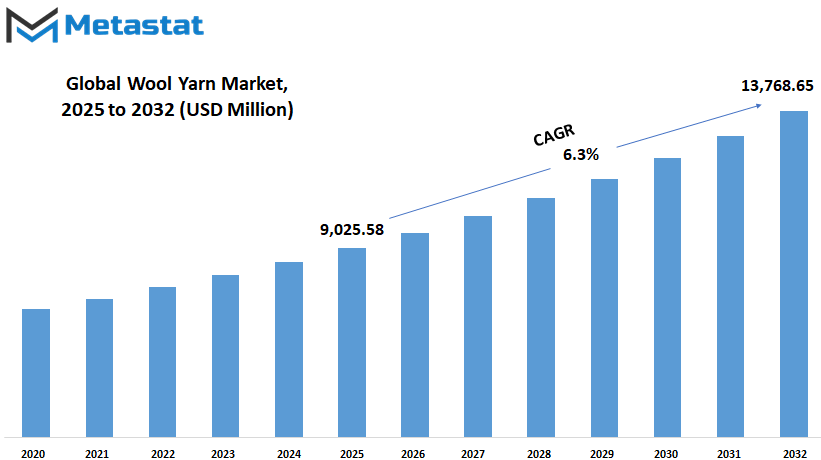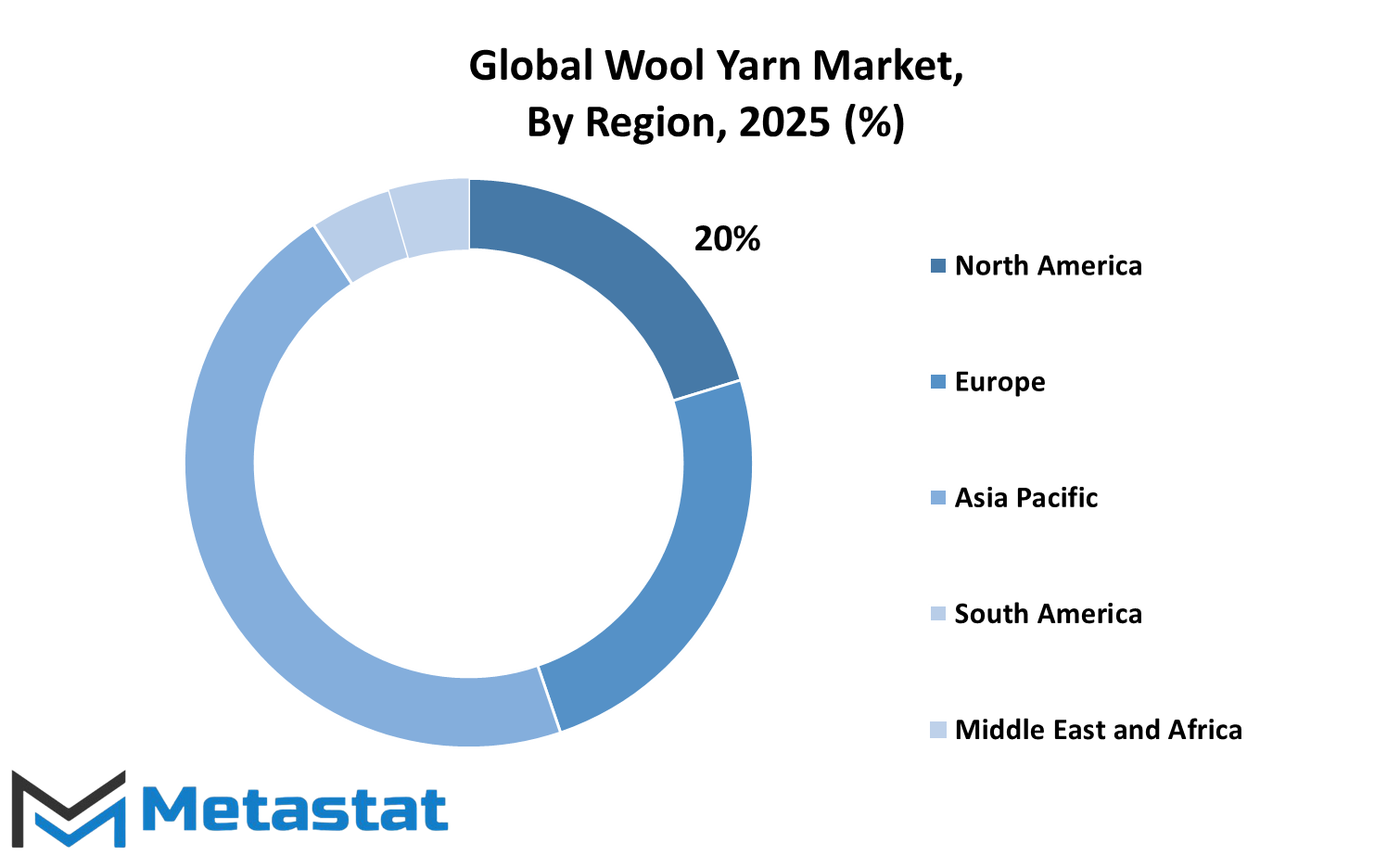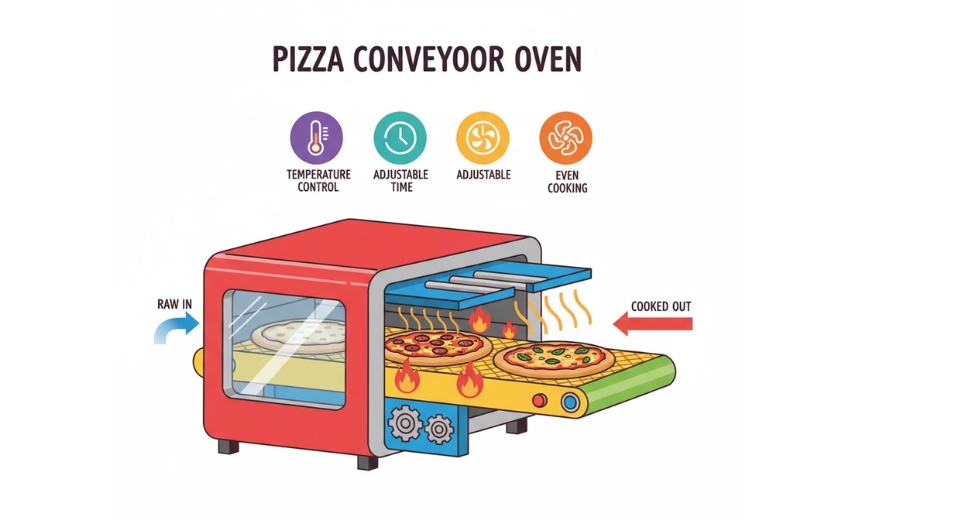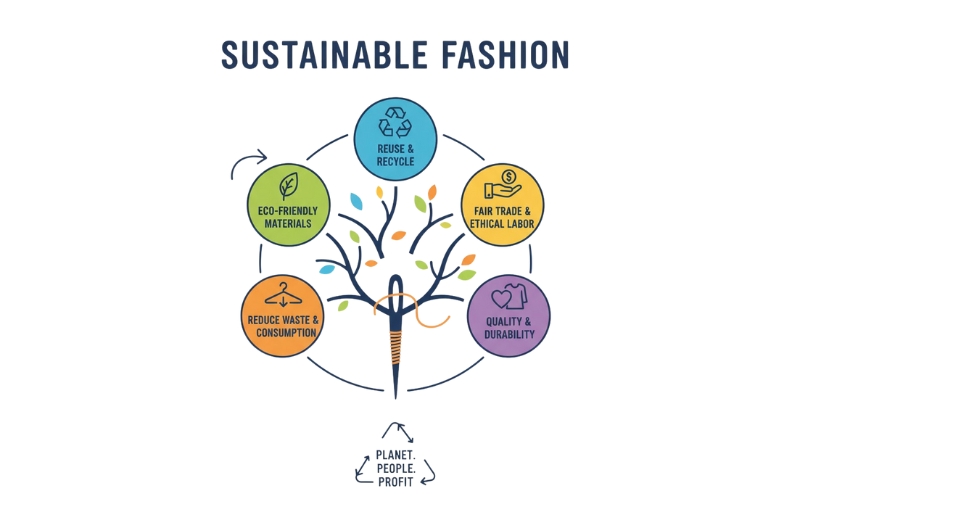MARKET OVERVIEW
The Global Wool Yarn market and industry play a significant role in the textile sector by providing an essential raw material for several applications, such as apparel, upholstery, and industrial fabrics. Wool yarn is obtained from the fleece of sheep and other wool-bearing animals through a number of processes that change it into a challenging and versatile fiber. This wool yarn industry links wool producers, the textile manufacturing industry, and the end-users, creating an integrated supply chain that meets global demand.
Wool yarn is broadly categorized on criteria like fiber length, fineness, and the technique of processing. The basic two types are worsted and woolen yarns, both having different properties and used accordingly in different applications for textiles. Worsted yarn, being smoother in texture and strong, is widely used for formal wear and fine fabrics. Woolen yarn preserves the soft texture and volume for knitted apparels and easy-wear types. This separation has much significance as it provides quality, use value, and attractiveness in final product outcomes among the producers in this sector.
Supply Chain - Sheep Farming to Finalized Products - In Global Wool Yarn market. The production process starts with wool shearing, then sorting, cleaning, carding, spinning, and dyeing. Advanced technological interventions are continuously refining these processes to enhance efficiency and sustainability. Automation and innovative spinning techniques have significantly impacted production, ensuring consistent quality and opening up possibilities for customized textiles. Sustainable and ethical sourcing has become a major focus, with increasing consumer awareness driving demand for eco-friendly and cruelty-free wool products.
The geographical distribution of the industry is diversified, with significant contributions coming from regions famous for wool production. Australia, New Zealand, China, and Argentina are some of the most important countries holding a significant share in the global wool supply. Meanwhile, textile hubs in Europe, North America, and Asia integrate wool yarn into various applications, from fashion to home textiles. Raw material producers and textile manufacturers determine the trends in the market because supply changes in wool, climate, and farming practice determine the capability to produce.
Wool yarn has been adaptable and integrated into other end-use industries. It remains a dominant sector for fashion and is applied to high fashion, winter garments, and collections. Home textiles include carpets, blankets, and upholstery fabrics, thus expanding the uses of wool yarn. Other industrial applications including insulation, filtration, and composite materials indicate functionality beyond simple conventional textiles. Performance-enhanced wool textiles will soon be made feasible by the developments in technologies such as moisture resistance, temperature regulation, and antimicrobial features.
The Global Wool Yarn market will change in accordance with evolving consumer preference, technological developments, and sustainable moves. The future of the industry lies in ethical wool sourcing, responsible farming practice, and ecoconscious production techniques. Increasing transparency, traceability, and regulatory compliance will require stakeholders throughout the supply chain to adapt to emerging standards and consumer expectations. The endeavor for the least environmental impact and biodegradable alternatives will contribute to the sustainable growth of the market over a considerable period. With the rise of new possibilities with innovations, demand for quality wool yarn will always be on an upswing and therefore is here to stay.
Global Wool Yarn market is estimated to reach $13,768.65 Million by 2032; growing at a CAGR of 6.3% from 2025 to 2032.

GROWTH FACTORS
Global Wool Yarn Market is expected to be on a growth spree in the coming years, driven by an increased demand for natural and sustainable textile products. This is because of consumers becoming increasingly environment-conscious and looking for more environmentally friendly alternatives; among these, wool yarn emerges as a preferable choice. The fashion houses are also following sustainability, hence taking woolen yarn into the collection to answer the demand of biodegradable and renewable fibers. This changing nature is affecting the industry directly, and they are forcing producers to adopt moral sourcing and ecological-friendly production mechanisms. The latest major factor of market growth can be seen with the increasing activity of do-it-yourself, also known as hand-knitting.
Increasing creative hobbies, consumers want to make unique pieces of craftsmanship. Personalized fashion and home decor have turned into a fad and an entire industry as part of the demand for high-quality wool yarn. Knitting and crocheting, long considered tedious old-lady activities, have been opened up to new people by social media platforms, and online tutorials. As a result, the market is witnessing a huge demand from hobbyists and small-scale artisans, who prefer wool for its warmth, durability, and aesthetic appeal. However, some challenges might slow the growth of the Global Wool Yarn market. High production costs are a concern since wool processing is resource-intensive-from sheep farming to spinning and dyeing.
Besides, raw material supply is not homogeneous across different regions, hence supply chain management is involving. Since most countries rely more on imported products, the changed trends in price result in varying production costs of the products. The competition is also from synthetic and blended yarns. They are at times cheaper, easier to maintain, and common, hence attractive for cost-conscious buyers. Synthetic fibers also possess certain performance properties, such as resistance to moisture and wrinkle resistance, which give them added attraction in some end-use applications. Despite the problems, though, the market remains promising. Awareness of environmentally friendly and socially responsible materials will further create expansion opportunities. Consumers want to buy products that epitomize their values, so manufacturers must be transparent in their sourcing and production processes.
Manufacturers are then contractually obligated toward innovative techniques-a good example in this case, organic wool farming or sustainably producing dyes-to meet customers' demands. The global market for wool yarn is expected to grow steadily based on technological support and increased investments in sustainable solutions for textiles. Opportunities are hereby available for all businesses that understand the importance of quality, sustainable, and production ethics.
MARKET SEGMENTATION
By Yarn Type
The global wool yarn market is growing very continually due to a variety of factors, including rising demand for wool-based products, ever-increasing interest in eco-friendly material application, and an increasing profile for the product within the textile and fashion industries. As consumers' preferences change over time, people still prefer wool yarn for its natural quality and versatility. The market would be in an upward trend as wool yarn products get more accessible and palatable for a wider audience.
The market can be segmented according to Yarn Type into Worsted and Woolen. Both Worsted and Woolen are the two types of wool yarn considered necessary in the manufacture of a variety of fabrics, as each holds specific characteristics that meet different consumer demands. However, Worsted yarns are often known for their smooth surface and strength and are made through combing the wool fibers so that impurities and shorter strands are removed. This process produces a yarn that is finer and more durable, making it suitable for high-end fabrics and items such as suits, scarves, and fine-knit garments. Woolen yarn, on the other hand, is thicker, softer, and bulkier, produced by carding wool fibers.
The result is a yarn with a more rustic appearance and a looser structure, often used for creating cozy sweaters, blankets, and other warm items. Looking forward, both of these two segments will experience further development. The demand for Worsted as well as Woolen yarn will increase.
When the trends of fashion move toward sustainable and natural fibers, wool yarn's flexibility will become much more valuable. The capability to accommodate both fine and chunky textures places wool in an excellent position to fulfill the multiple requirements of numerous industries, such as high-fashion luxury and even simple everyday garments and home accessories. Advances in wool yarn production techniques will doubtless lead to the development of new kinds of yarn, providing consumers and producers with additional alternatives. The future of the wool yarn industry seems promising because of interest for sustainable materials.
There is, in addition, a continued drift toward eco-conscious choices in textiles. Wool yarn will become even more important as demand for natural fibers increases. The expanding applications and versatility of both Worsted and Woolen yarns mean that wool will continue to be a necessary ingredient in the fabric of tomorrow's fashion, home goods, and industrial textiles. This market will grow as consumers continually look for better production technologies and applications for Global Wool Yarn.
By Wool Type
The Global Wool Yarn market is a significant segment of the textile and fashion industry and is currently experiencing a dynamic shift in trends and preferences. With people embracing the natural, renewable, and sustainable qualities of wool, demand for wool yarn is expected to continue expanding. There are thousands of types of wool, and each has properties that make it suitable for use in knitting, weaving, and other textile production. Consumer preferences, environmental awareness, and manufacturing developments are expected to be some of the factors that will determine the demand for wool yarn in the coming future.
Merino Wool is soft and fine, and on the market it occupies a leading position among wool yarn. Such material has been a symbol of comfort and luxury for ages. With sustainability becoming such a pressing issue, Merino Wool is sure to be in demand for it is a natural and biodegradable material. Furthermore, Merino wool is very versatile, with a rather vast range of applications to both fashion and sportswear. Its temperature regulating, moisture wicking, and breathability guarantee its popularity with manufacturers in this day and age of growing consciousness among consumers about fabric choices.
Another variant that is expected to attract growing interest is Peruvian Highland Wool from Peru's high-altitude regions. Known for their endurance and warmth, these types of wool are perfectly suited for making cold-weather garments and blankets. As consumers continue to prioritize eco-friendly products, the demand for Peruvian Highland Wool is expected to rise. The future of this wool type will depend on the continued growth of sustainable fashion and the increasing popularity of region-specific materials.
Other wool varieties that are probably going to show greater market growth are Teeswater Wool. Teeswater Wool is used in weaving intentions and high quality yarn production. Being rich with a glossy and lustrous surface, Teeswater Wool has been preferred the most to create luxurious textiles. As fashion industries are currently looking forward to introducing natural fibers into luxury items, Teeswater Wool is going to become an essential element of future market trends.
Shetland wool, originally from the Shetland Islands, distinguished unique texture, and remarkable usage in handicrafts. This wool is much favored by several craft enthusiasts to offer light but thick warmth. Amongst its highly loyal bases, too, this wool boasts. Shifting more towards domestic handcrafts productions in the increasing demand to experience true craft along with native texture it also becomes apparent that the future will only witness the increase of such demand.
Cashmere Wool will remain highly in demand within the Global Wool Yarn market as it has a luxurious feel and warmth combined with a light as feather weight. Cashmere Wool is likely to be among the maximum-continuation bets of high-end fashion and luxury goods for those who continue their search in the category. The time ahead for Cashmere Wool will depend on how it sustains the prestige of a luxury good while managing the growing pressure of sustainability and concern over animal welfare issues.
By Application
The Global Wool Yarn market will likely witness steady growth over the next few years. This is because the products are used in various industries. Wool yarn is one of the oldest staple components of the textile industry. It has seen change with improvements in manufacturing and consumers' preference towards new developments in its use. Sustainable conditions are now considered part of most buying decisions, so demand for products that are disposed of in the environment without harming it is increasing rapidly. Wool is a natural fiber; hence, this trend supports it as the preferred choice over synthetic options. In turn, preferences like this will fuel growth as apparel, upholstery fabrics, blankets, flooring, and other textile-based products continue to be sought after. Wool yarn is still the most important market segment in apparel.
The market is now in search of premium, durable, and comfortable clothing, which wool offers. Additionally, growing interest in ethical fashion and sustainable sourcing is compelling brands to increase wool-based products in their collections. With softness and the ability to have better moisture wicking, the wool garments would be versatile, and it is suitable for almost all climates; therefore, wool will find new uses in casual and high performance wear, an indispensable item around the world. Upholstery Fabrics in wool yarn are gaining popularity these days due to their durability against wear and tear. Premium, time-to-last furniture producers are now using wool blends in their designs.
Wool-based upholstery will be a favorite in homes seeking comfort, style, and eco-friendliness as smart homes and sustainable interior designs emerge. Wool can naturally regulate temperature, and it repels dust mites, so it is best suited for the indoor environment. The demand for blankets made of wool yarn is also increasing as customers look for warmth and comfort in their houses. With the increasing need for quality breathable and insulating bedding, wool blankets stand out as the best option. With growing awareness over natural fibers, wool blankets will continue gaining popularity in residential as well as hospitality sectors.
Wool yarn is widely used in the flooring industry, specifically in carpets and rugs. Since wool products do not shed when laid on, they find considerable use, after being fitted into homes, buildings, etc., as neither will they loose the texture over the years. Their increasing consumption depends on various parameters like change of interior trends with the changing building construction needs, etc. Beyond these key areas, wool yarn finds applications in various other products, including decorative items, industrial textiles, and crafts. The versatility of wool, coupled with ongoing innovations in textile technology, will ensure its continued relevance in diverse industries. With sustainability, durability, and comfort driving consumer choices, the Global Wool Yarn market is poised for a promising future.
By Apparel
The Global Wool Yarn market will have immense growth in the coming future years, all being driven by consumer preferences evolving further, sustainability concerns, and advancing technology in the textiles sector. The wool yarn is longer known for the strengths of durability, softness, and warmth provision; this makes it the fundamental base in textile sectors for clothing purposes. In a situation wherein demand is bound for green or quality-oriented material, woolen yarn holds the strongest foundation among textile material.
One of the primary market indicators that dictates growth in demand lies in premium or high-quality garment products. Demand is up nowadays for more discerning people for their comfort needs in the feel and the assurance that clothes worn last long and would be preferred by those choosing material with proper care in place. Wool yarn is used in the production of several types of clothing, such as sportswear, blazers, jackets, and other fashion products. In sportswear, it is gaining usage due to its temperature-regulating properties and moisture-wicking functionality that keeps the wearer relatively dry and cool. Athletes and outdoor enthusiasts appreciate natural wool breathability, which keeps them comfortable regardless of weather conditions. Blazers and formal wear add up to the usage of wool yarn.
This is a nice-looking, durable fabric; professionals use it as well as people who will wear fashionable, functional clothing. Wool yarn holds its form wonderfully, does not wrinkle easily; such properties help attract high-end fashions even more. Wool jackets are also very warm, but the garment is not heavy, hence its popularity among people during winter. Other clothing apart from those three above which make use of wool yarn includes the sweater, the scarf, and traditional garments among different people's cultures. Sustainability is also propelling the Global Wool Yarn market forward. Given that there is now increased awareness on the negative impact of synthetic fibers on the environment, most customers and businesses opt for natural products that are also biodegradable.
Wool, being recyclable and renewable, is just about at the top. Even more important are ethical sourcing and responsible production practices, where companies are using transparent supply chains. This, undoubtedly, is going to propel demand for wool yarn further as sustainability will continue to remain a focus point for both the manufacturer and the end-user. Innovation in the area of manufacturing itself is likely to boost growth even more in this market. Improved spinning techniques and dyeing and all treatments done on the wool will make yarn stronger, longer, softer, and indeed attractive to be utilized in wide applicability ranges.
Hence, enhanced strength, low shrinkage percentages, and a percentage addition to water resistance help in reaching out for more utilizable applications on the wool blend. Going forward, the Global Wool Yarn market is set to progress steadily with the changing trends in fashion, rise in sustainability concerns, and evolving technology that continues to increase product quality. Wool yarn is, therefore likely to remain a material of worth in the textile industry.
|
Forecast Period |
2025-2032 |
|
Market Size in 2025 |
$9,025.58 million |
|
Market Size by 2032 |
$13,768.65 Million |
|
Growth Rate from 2024 to 2031 |
6.3% |
|
Base Year |
2024 |
|
Regions Covered |
North America, Europe, Asia-Pacific, South America, Middle East & Africa |
REGIONAL ANALYSIS
Wool yarn is an industry that is currently expanding all over the world due to a shift in consumer preference, advancement of technology, and regional economic change. Demand for wool yarn in each region determines the nature of the industry since demand patterns are different for every region based on climate, lifestyle, and industrial growth. Businesses will be interested in the future trends and understanding the differences among regions.
North America has remained a major player, with the U.S., Canada, and Mexico all contributing to the market. The region's strong textile industry, well-established supply chain, and increasing interest in sustainable fashion ensure steady growth. Consumers in North America show an affinity for ethically sourced wool, which means that producers place more focus on traceability and eco-friendly production. Ahead of the curve, new innovations in wool processing and sustainable farming will further expand this market in this region. Europe has always been a center for high-quality wool products, where countries like the UK, Germany, France, and Italy are the ones having the highest influence.
Premium and luxury wool textiles remain strong in the region as a result of the rich heritage of craftsmanship. In Europe, sustainable fashion movements are forcing the manufacturers to shift towards eco-friendly techniques. This is going to be shaped up by consumer awareness, where recycling wool and use of biodegradable dyes will become popular in the coming future. The Asia-Pacific region is a prominent force in terms of wool yarn production and consumption. India, China, Japan, and South Korea are currently leading this area. The Chinese market is prominent among these, because of the large-scale manufacturing capabilities and growth in home market demand.
The Indian textile industry is growing too because of government support and a rising preference for natural fibers. However, as technology advances, this will be complemented by automation and smart manufacturing to make the region a driving force of the future of the global market. South America, from Brazil and Argentina, is driving the industry further through the emerging textile sector with increased exports. The region remains a huge development area with room for growth with an interest in high-quality natural fibers.
In the light of investments to improve production facilities to be sustainable could position South America as a leading competitor in international markets. Gradual growth is seen in the Middle East & Africa, including GCC countries, Egypt, and South Africa, with an increasing demand for quality textiles. The region has a developing textile industry, but improvements in infrastructure and trade policies could enhance its presence in the market. Investments in wool production and textile innovation will determine how this region strengthens its role in the global industry in the future.

COMPETITIVE PLAYERS
Today, the global wool yarn market is going through drastic change with various industry key players taking initiatives towards the same. Among them, major names are American Woolen Company, Ferney Spinning Mills Limited, and Geetanjali Woolens, playing a crucial role in the same while paving their path for further innovations in the production and distribution of wool yarn. These companies are expected to continue evolving to meet the growing demand for wool yarn, especially in the fashion, textile, and home decor industry.
In the next few years, the businesses, including Henan First Textile & Apparel (Group) Co. Ltd. and HTX- Shanghai Huaxiang Woolen Co., Ltd., are expected to grow into new markets through innovative and sustainability-oriented operations. Sustainability is a growing concern for both producers and consumers, and players such as Indorama Ventures Public Company Limited and Jayashree Textiles are already adapting their strategies to produce more eco-friendly yarn options. This is likely to influence the broader market in the long run as the demand for more ethical and environmentally conscious production practices continues to rise.
The future of the wool yarn industry is going to see companies like John Marshall & Company (Joma) and KentWool focus on quality and functionality in their yarn products, which will give them a competitive edge in the market. The companies will find new materials and techniques that will enhance durability and versatility. Furthermore, their significant brand presence in particular regional and sectoral markets will further enable them to gobble up an even bigger chunk of market share in the future.
Companies like Lawton Yarns and Ortovox will be part of the wool yarn market and invest highly in diversified products in the near future. These players will expand their product lines and use advanced textile technologies to stay ahead in the global market, which is becoming more competitive. Demand for wool yarn will be increasing beyond traditional uses such as outdoor apparel and sportswear, and companies like Rosy Woollen Mills Pvt. Ltd. and Shandong Hengtai Textile Co. Ltd. are likely to play a key role in meeting these demands.
As the market expands, Shanghai Charmkey Textile Co., Ltd. and Shanghai Token Cashmere Co., Ltd. would probably expand further into the world market by coming up with specialized solutions that best suit the diversified needs of specific markets. At the same time, companies such as Sharman Woolen Mills Ltd. and Sudwolle Group will pay more attention to maintaining long-term relationships with customers by continually raising the quality standards of their products and services.
With such focus on benefits from the aspects of sustainability as well as performance, The Woolmark Company and Wool Yarns of New Zealand will drive wool yarn sales into further expansion in the international wool yarn market.
Wool Yarn Market Key Segments:
By Yarn Type
- Worsted
- Woolen
By Wool Type
- Merino Wool
- Peruvian Highland Wool
- Teeswater Wool
- Shetland Wool
- Cashmere Wool
- Others
By Application
- Apparel
- Upholstery Fabrics
- Blankets
- Flooring
- Others
By Apparel
- Sports
- Blazers
- Jacketing
- Others
Key Global Wool Yarn Industry Players
- American Woolen Company
- Ferney Spinning Mills Limited
- Geetanjali Woolens
- Henan First Textile & Apparel (Group) Co. Ltd.
- HTX- Shanghai Huaxiang Woolen Co.,Ltd.
- Indorama Ventures Public Company Limited
- Jayashree Textiles
- John Marshall & Company (Joma)
- KentWool
- Lawton Yarns
- Ortovox
- Rosy Woollen Mills Pvt. Ltd.
- Shandong Hengtai Textile Co. Ltd
- Shanghai Charmkey Textile Co.,Ltd
- Shanghai Token Cashmere Co.,Ltd
WHAT REPORT PROVIDES
- Full in-depth analysis of the parent Industry
- Important changes in market and its dynamics
- Segmentation details of the market
- Former, on-going, and projected market analysis in terms of volume and value
- Assessment of niche industry developments
- Market share analysis
- Key strategies of major players
- Emerging segments and regional growth potential








 US: +1 3023308252
US: +1 3023308252






